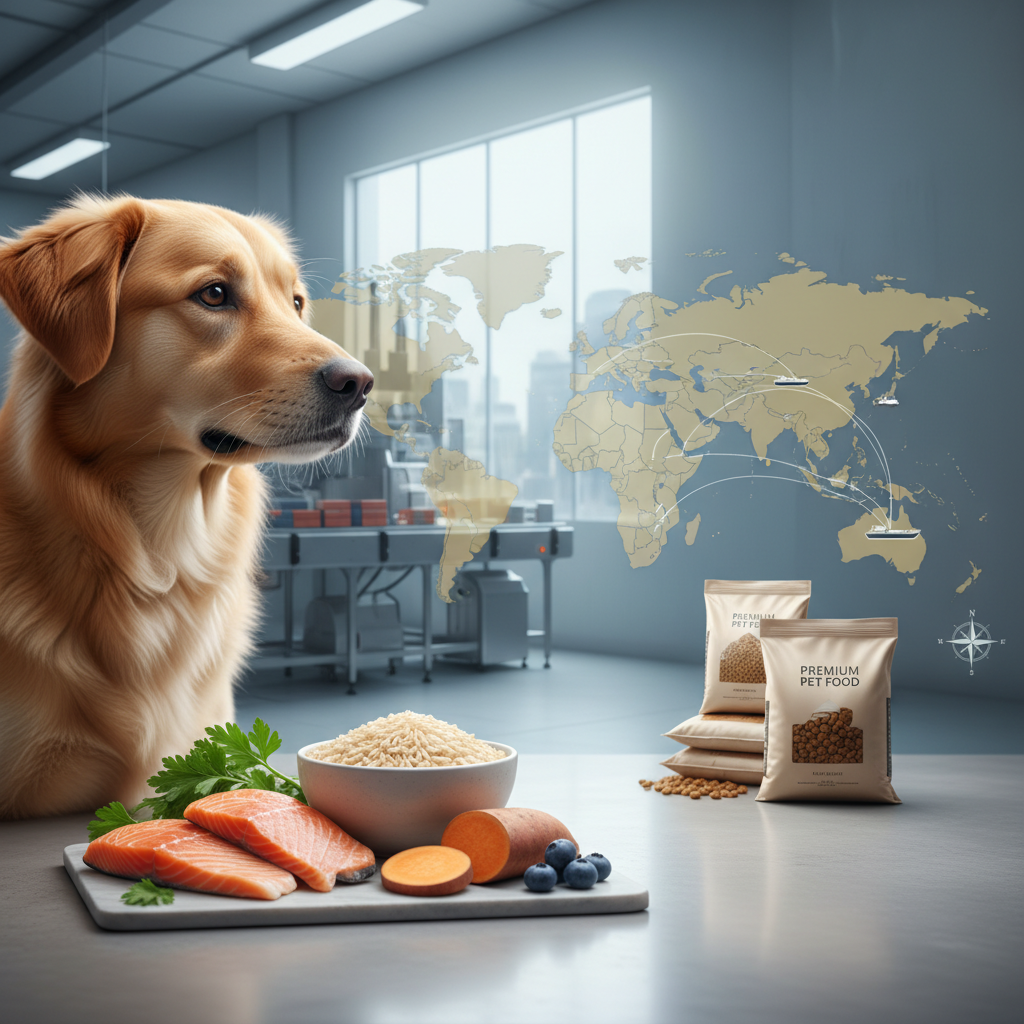

The global pet food industry is a vibrant ecosystem, constantly evolving with consumer preferences and economic shifts. For B2B stakeholders—importers, distributors, wholesalers, manufacturers, and private label brand owners—identifying and capitalizing on high-growth regions is paramount. Southeast Asia stands out as a beacon of opportunity, presenting a dynamic landscape for dog food exports. With its burgeoning middle class, increasing pet ownership, and growing disposable incomes, the region is ripe for businesses ready to navigate its unique challenges and leverage its immense potential. This comprehensive guide is designed to equip you with the insights and actionable strategies needed to succeed in exporting dog food to Southeast Asia. We'll delve into market dynamics, regulatory frameworks, supply chain intricacies, and the strategic advantages of private labeling, ensuring you have the knowledge to make informed decisions and foster sustainable growth.
The Allure of Southeast Asia's Pet Food Market
Southeast Asia, home to over 670 million people, is a mosaic of diverse cultures and economies experiencing rapid development. This growth directly fuels the expansion of its pet care sector, making it an increasingly attractive destination for dog food exporters.
Market Growth and Opportunities
The pet humanization trend is exceptionally strong across Southeast Asia, with pet owners treating their animals as cherished family members. This sentiment drives demand for premium, nutritious, and specialized dog food products. Countries like Singapore, Thailand, Malaysia, Indonesia, and Vietnam are witnessing significant year-on-year growth in pet ownership and expenditure. The market isn't just expanding in volume; it's also maturing in sophistication, with a rising demand for products addressing specific dietary needs, life stages, and health concerns. This includes grain-free options, natural ingredients, breed-specific formulations, and veterinary diets. For B2B players, this translates into opportunities across the value chain, from raw material sourcing for local manufacturers to importing finished premium products for distribution.
Key Consumer Trends Driving Demand
Understanding the consumer landscape is crucial. Southeast Asian pet owners are increasingly informed and discerning. Key trends include:
- Premiumization: A willingness to pay more for high-quality, perceived healthier options.
- Natural and Organic: Demand for products free from artificial colors, flavors, and preservatives.
- Health and Wellness: Focus on functional ingredients that support joint health, coat condition, digestion, and immunity.
- Sustainability: A nascent but growing interest in eco-friendly packaging and ethically sourced ingredients.
- E-commerce Growth: Online platforms are becoming dominant channels for pet food purchases, especially among younger demographics.
These trends underscore the need for exporters to offer differentiated products that align with local consumer values and expectations.
Navigating Regulatory Landscapes and Compliance
Exporting dog food is not merely about finding a market; it's about successfully navigating a labyrinth of international and local regulations. Each country in Southeast Asia has its own set of rules governing pet food imports, which can vary significantly.
Understanding Import Regulations: A Multi-Country Perspective
Compliance is non-negotiable. While general principles apply, specific requirements differ.
- Singapore: Known for strict biosecurity measures. All imported pet food must comply with the Agri-Food & Veterinary Authority (AVA) regulations, including import licenses and health certificates. Ingredient lists are scrutinized.
- Malaysia: Governed by the Department of Veterinary Services (DVS). Importers need licenses, and products must adhere to Malaysian standards, often requiring lab testing and specific labeling.
- Thailand: Regulations are overseen by the Department of Livestock Development (DLD). Pet food products need to be registered, and facilities of origin often require approval.
- Indonesia: The Ministry of Agriculture sets standards. Products must be registered, and halal certification might be an advantage, though not always mandatory for pet food.
Thorough due diligence for each target market is indispensable. Engaging with local partners or consultants can significantly streamline this process.
Documentation Requirements Checklist
Prepare for extensive paperwork. While not exhaustive, this checklist covers common documents required:
- Import Permit/License: Issued by the veterinary or agricultural authority of the importing country.
- Veterinary Health Certificate: Issued by the competent authority in the exporting country, confirming the product's safety and origin.
- Certificate of Origin: Verifies the country where the goods were manufactured.
- Commercial Invoice: Details the transaction between exporter and importer.
- Packing List: Itemizes the contents of each package.
- Bill of Lading/Air Waybill: Contract between the owner of the goods and the carrier.
- Ingredient List and Analysis: Detailed breakdown of all ingredients and nutritional analysis.
- Labels: Must comply with the importing country's language and content requirements.
Ensure all documents are accurate, consistent, and translated into the required languages.
Ingredient and Labeling Standards
Beyond general documentation, ingredient composition and labeling are critical. Many countries have restricted ingredient lists or require specific sourcing declarations. For instance, some may prohibit certain animal by-products or demand specific certifications for raw materials. Labeling must often include:
- Product name and brand
- Net weight
- Ingredient list (in descending order by weight)
- Guaranteed analysis (e.g., crude protein, fat, fiber, moisture)
- Feeding guidelines
- Manufacturing and expiry dates
- Country of origin
- Importer's name and address
Non-compliance in labeling can lead to product rejection, costly re-labeling, or even fines.
Optimizing Your Dog Food Supply Chain for Export
A robust and efficient supply chain is the backbone of successful international trade. For dog food, this involves careful consideration from raw material sourcing to final delivery.
Sourcing High-Quality Raw Materials
The quality of your finished product begins with its ingredients. For manufacturers, securing reliable sources of high-quality, human-grade raw materials is paramount. This often involves:
- Ingredient Traceability: Ensuring you can track ingredients back to their origin.
- Supplier Audits: Regularly vetting suppliers for quality control, ethical practices, and compliance with international standards (e.g., HACCP, GMP).
- Strategic Partnerships: Building long-term relationships with key suppliers for consistent quality and pricing.
For importers and distributors, understanding the sourcing practices of your manufacturing partners is essential for quality assurance and brand reputation.
Manufacturing and Quality Control Best Practices
Maintaining stringent quality control throughout the manufacturing process is non-negotiable, particularly when catering to diverse international markets.
- Accreditation: Adhering to international standards such as ISO 22000 (Food Safety Management) or BRCGS (Brand Reputation Compliance Global Standards) demonstrates commitment to quality.
- HACCP Implementation: A Hazard Analysis and Critical Control Points system is crucial for identifying and preventing potential food safety hazards.
- Batch Testing: Regular testing of finished products for nutritional content, contaminants, and pathogens ensures consistency and safety.
- Packaging Integrity: Ensuring packaging protects the product from moisture, pests, and damage during transit, and clearly displays all required information.
These practices not only ensure compliance but also build trust with B2B partners and end-consumers.
Logistics and Cold Chain Management
Dog food, especially certain types like fresh or raw diets, may require specific handling. Even kibble and wet food benefit from optimized logistics.
- Freight Forwarders: Partner with experienced freight forwarders specializing in pet food or perishable goods and familiar with Southeast Asian customs.
- Incoterms: Clearly define Incoterms (e.g., FOB, CIF, DDP) in your contracts to avoid ambiguity regarding responsibilities and costs.
- Warehousing: Consider strategic warehousing options in or near your target markets to reduce lead times and improve responsiveness.
- Cold Chain (if applicable): For products requiring temperature control, invest in reliable cold chain logistics to maintain product integrity from factory to shelf.
Efficient logistics minimize spoilage, reduce costs, and ensure timely delivery, crucial for maintaining retailer relationships.
Private Labeling: A Strategic Entry Point
Private labeling offers a compelling pathway for B2B entities to establish their presence or expand their footprint in Southeast Asia without the complexities of building manufacturing facilities from scratch.
Benefits of Private Labeling in Southeast Asia
For importers, distributors, and brand owners, private labeling provides numerous advantages:
- Market Responsiveness: Quicker entry into the market with products tailored to local tastes and trends.
- Cost Efficiency: Reduced R&D and manufacturing overheads by leveraging existing production capabilities.
- Brand Control: Full control over brand identity, marketing, and pricing strategies.
- Flexibility: Ability to adapt product lines rapidly based on market feedback.
- Scalability: Easier to scale production up or down based on demand without significant capital investment.
This model is particularly attractive for businesses looking to capitalize on specific niche markets or introduce premium lines.
Choosing the Right Manufacturing Partner
The success of your private label venture hinges on selecting a reliable manufacturing partner. Look for partners who offer:
- Experience: Proven track record in pet food manufacturing and international standards.
- Certifications: Compliance with relevant food safety and quality accreditations (e.g., ISO, HACCP, GMP).
- Flexibility: Willingness to accommodate custom formulations, packaging, and minimum order quantities (MOQs).
- Transparency: Open communication regarding ingredient sourcing, production processes, and quality control.
- Logistical Support: Ability to assist with export documentation and logistics.
A strong partnership is built on mutual trust and shared commitment to quality.
Branding and Market Positioning
Even with private label products, effective branding and market positioning are vital.
- Local Appeal: Develop packaging and marketing messages that resonate with local cultures and languages.
- Differentiation: Highlight unique selling propositions (USPs) such as specific ingredients, health benefits, or ethical sourcing.
- Digital Presence: Leverage e-commerce platforms and social media to reach consumers directly and build brand loyalty.
A well-defined brand strategy can transform a private label product into a market leader.
Actionable Strategies for B2B Success
Beyond understanding the market and regulations, strategic execution is what truly drives success in Southeast Asia.
Building Strong Partnerships
The B2B landscape in Southeast Asia is highly relationship-driven.
- Local Distributors: Partner with established local distributors who have extensive networks, market knowledge, and logistical capabilities.
- Retailers: Cultivate relationships with key retailers, both brick-and-mortar and online, to ensure optimal shelf presence and visibility.
- Veterinarians and Breeders: Engage with veterinary clinics and professional breeders who often act as trusted advisors and recommend specific pet food brands.
Trust and reliability are cornerstones of successful B2B collaborations in this region.
Market Research and Adaptation
The Southeast Asian market is not monolithic; it's a collection of diverse economies.
- Continuous Research: Invest in ongoing market research to stay abreast of evolving consumer preferences, competitor activities, and regulatory changes.
- Product Localization: Be prepared to adapt formulations, packaging sizes, and pricing strategies to suit specific country needs and economic conditions.
- Pilot Programs: Consider launching pilot programs in smaller, more accessible markets before expanding regionally.
Flexibility and a willingness to adapt are key to long-term success.
Digital Presence and E-commerce Integration
E-commerce is booming in Southeast Asia, offering direct access to consumers.
- Platform Strategy: Identify and utilize popular e-commerce platforms (e.g., Shopee, Lazada, Tokopedia) in each target country.
- Social Media Engagement: Leverage platforms like Facebook, Instagram, and TikTok for brand building and direct consumer interaction.
- Influencer Marketing: Collaborate with local pet influencers to build credibility and reach a wider audience.
A robust digital strategy is no longer optional; it's a necessity for market penetration.
Conclusion
The Southeast Asian dog food market presents unparalleled opportunities for B2B enterprises ready to engage strategically and ethically. From understanding the nuanced regulatory environments to optimizing supply chains and exploring private labeling avenues, success hinges on meticulous planning, strong local partnerships, and an unwavering commitment to quality. By embracing these insights and actionable strategies, importers, distributors, wholesalers, manufacturers, and private label brand owners can unlock significant growth and establish a lasting presence in this dynamic and rewarding region. Are you looking to expand your dog food business into the vibrant markets of Southeast Asia? Partner with us to navigate these complexities and transform challenges into growth opportunities. Contact us today to discuss how our expertise in global trade, supply chain optimization, and private label solutions can help you achieve your export ambitions.


